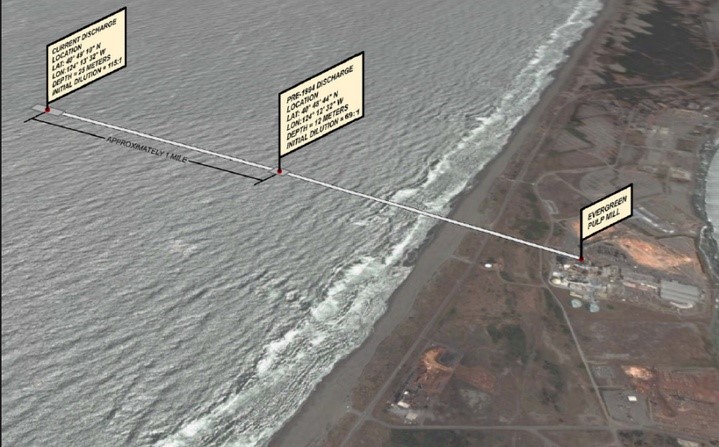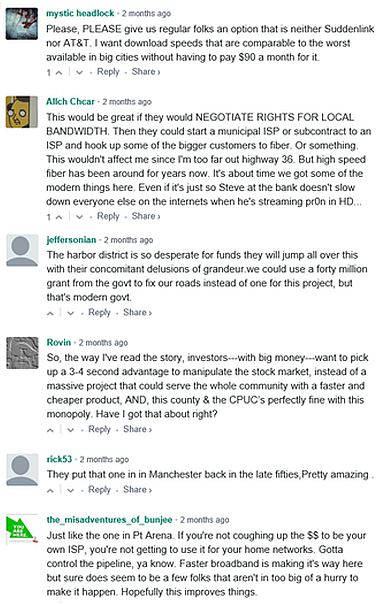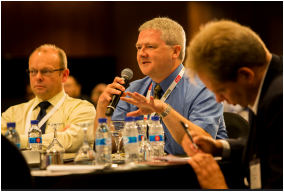|
Humboldt County may be about to get a fat new fiber-optic connection that taps directly into undersea trunk lines running off our coast. At its regular meeting, the Humboldt Bay Harbor, Recreation and Conservation District will consider entering into an agreement with a Rancho Cucamonga-based company called Inyo Networks that seems likely to culminate in some sort of blisteringly fast data connection to the outside world. The full details of the proposed deal are still sketchy, but in short: Inyo Networks proposes to pay the Harbor District around $1.75 million to run four fiber optic cables up the wastewater discharge pipe that runs from the old Samoa pulp mill, now known as Redwood Marine Terminal II, out to sea. Figure 4 - Redwood Terminal 2 Outfall Pipe Map Source: SHN Consulting Engineers Harbor District Commissioner Richard Marks, who said that he has met with company officials, stated that he was not at liberty to say much about the deal at the moment, but affirmed that it would be discussed in some depth. “If it all comes to fruition, it will be a great thing for community,” Marks said. Transpacific fiber optic cables land in several small cities along the Oregon and California coast: in Bandon and in Point Arena to name a couple. Presumably, the former pulp mill would be a desirable spot to land another such cable, or a branch off some undersea trunk line, because no additional infrastructure would be required to get the cable between the ocean and terra firma. The mill’s so-called “outfall pipe”, a three-foot-wide tunnel, runs directly from the Redwood Marine Terminal to a spot in the ocean a mile and a half from shore, and about 80 feet deep. The four fiber optic cables proposed by Inyo Networks would be threaded up that pipe and into the terminal, which the Harbor District acquired along with the outfall pipe, in 2013. Currently, the pipe discharges about 60,000 gallons of wastewater per day from the DG Fairhaven power plant, located down the peninsula. Marks said that running Inyo Networks proposal would not interfere with current or future use of the outfall pipe to discharge wastewater. What would Inyo Networks do with its Humboldt Bay fiber hookup? Should it be built? Not much is public at the moment, and it’s not clear whether anything substantive will be released at tomorrow night’s meeting. However, the terms of the “exclusive right to negotiate” contract, which will be discussed and/or signed at the meeting, provide that the company will release a “narrative description of the development proposed,” along with sources of funding and a timeline for construction. The company’s website shows that it offers a number of digital services. It is a major partner in the “Digital 395” project, which runs a fiber line between Barstow and Carson City, NV, along the eastern Sierras. They run an ISP offering 1 gigabyte-per-second service to homes and businesses around the city of Ontario, CA. They also seem to offer co-location in server farms they operate in California and Nevada. The latter service seems plausible for the Redwood Terminal, which has space for lease, is supplied with an abundance of industrial water and is located in a (famously) cool climate. Update 1/26/17: "That Superfast Undersea Internet? You’re Probably Not Getting It, Unless You are One of 307 People Who Live in Lewiston" Humboldt County internet consumers won’t be able to buy blazing fast service from the new fiber optic cables that might soon rise onto the Samoa Peninsula, Kraken-like, from the sea. Rather, that privilege will be reserved exclusively for 307 residents in the tiny Trinity County town of Lewiston, who — if all goes according to plan — will be able sign up for a smoking 1 gigabit/second download connection and fiber directly to their door, all for the reasonable price of $60 per month. Not in Lewiston? Unless you are a school, government office, tribal entity, cell phone company or Humboldt State University, you’re probably not getting the hookup. These and other details of Inyo Networks’ “Digital 299” project can be found on the website of the California Public Utilities Commission. Inyo is seeking $41 million from the commission’s Broadband Infrastructure Grant program to land fiber optic lines at the old Samoa pulp mill and to lay down new fiber from here to Redding, with a few stops along the way (including, most importantly, Lewiston). Why will Lewiston get this deal, when we won’t? The answer lies in the details of the CPUC’s grant program. The commission offers these grants to companies who propose to bring the internet to places currently “unserved or underserved” by existing broadband companies. Lewiston happened to fit the bill. Even the town’s Wikipedia page bemoans its terrible connectivity. But why can’t we get the same deal as the Lewistonians, seeing as how the fiber passes right through our backyard anyway? Well, as it stands, existing broadband companies can challenge CPUC grant applications that infringe on their turf. Originally, Inyo Networks had proposed to bring its $60, gigabit-per-second deal to the community of Hayfork, Douglas City and Burnt Ranch, as well. But two existing telecoms — Frontier and Velocity — challenged the grant, saying that they already provide fast enough broadband to those towns, or would provide it soon. According to a CPUC staff report, Inyo cut a deal with those two companies and limited their last-mile fiber plans to the lucky 307 in Lewiston, at which point those other companies withdrew their objections. Humboldt County and other communities along the “Digital 299” route will still see some benefit from the project, even if consumers don’t get to buy their bandwidth from Inyo Networks directly. The staff report notes that the bulk of the funding requested by Inyo will go to “middle mile” projects, such as additional cell phone towers along Highway 299. Humboldt State University will also get direct access to the fiber, and the company plans to run a spur line up to Hoopa to serve tribal government, area schools and medical facilities. All told, the staff report says, “as many as 117 schools, colleges, research institutions, hospitals, clinics, public safety, tribal lands, and other Community Anchor Institutions” could benefit from the project. In addition, the line would provide yet more redundancy to existing telecommunications companies that might wish to rent bandwidth, and would provide a direct northern California connection to trans-Pacific trunk lines. As we talked about yesterday, the Harbor District would get $1.75 million one-time payoff for providing a landing spot for the cable, via the outfall pipe at the old pulp mill, which the district now owns. And there’s always the chance that once the infrastructure is in place, regulations regarding competition in the telecom sector might relax. Nevertheless, the project is not without some controversy. Michael McKaskle, a member of the board of the Redway Community Services District and two-time LoCO contributor, sits on the board of the Redwood Region Economic Development Commission. Last night he commented in the Thunderdome that he voted against sending a letter of support for the project when it came before the RREDC board: I voted against it because I feel that if the people are going to pay more than 2/3 of the cost we should own at least 2/3 of it, never mind the public gift of right of way. It is a very valuable item. The ocean landing is super valuable and the district should get way more for it. There are very few spots left on the California coast and the industry is already looking at landings in OR. They want close connections to facilitate high speed trading on Asian markets and want the few micro seconds advantage. Also Google is rumored to be considering a server farm near the Trinity river dam because of the cheap power and that would be a huge user of the line. Strange as a Trinity County Google facility might seem, the CPUC staff report does lend it some credibility. “Project proponents also see opportunities for developing hosting facilities or data centers in Trinity County, which presently has a low-cost and under-utilized electrical power capacity,” it reads. The Humboldt Bay Harbor, Recreation and Conservation District meets tonight at 7 p.m. to discuss/approve a deal to land Inyo’s fiber at its Redwood Marine Terminal II. That’s at the district headquarters on Woodley Island (601 Startare Drive, Eureka). The California Public Utilities Commission will approve or deny the grant for the “Digital 299” project at its regular meeting on Feb. 9, in San Francisco. If you wish to comment on the project, you can email your comments to CPUC staffer John Baker: [email protected]. Access Humboldt’s Sean McLaughlin tells us that comments are due by Jan. 30. Source: https://lostcoastoutpost.com ANALYSIS: There is an increasing buzz along the entire Pacific coastline of the United States from entrepreneurs looking to take advantage of the growing need for connectivity across the Pacific Ocean through real estate deals. Coastcom has attracted the "Hawaiki" (Australia-NZ-USA) cable project to its cable landing station (CLS) in Pacific City, OR; RTI is planning to construct four shore-end cables from its CLS in Hermosa Beach, one of which will be used for the SEA-US transpacific cable while the others are in anticipation of offering pre-permitted landings to future transpacific cables; The Digital Transportation Corporation (DTC) is proposing to use access to an outfall pipe in Moss Landing, Monterey Bay, CA to construct a shore-end cable to interconnect with an unspecified transpacific submarine fiber optic system; and now, Inyo Networks are proposing practically the same concept in Humboldt Bay, northern California. While there is no doubt that long-term growth in demand for transpacific connectivity is robust and permitting along this coastline is always on the critical path of any proposed submarine fiber optic cable project, the speculative approach being taken by entrepreneurs, to focus on the landing, rather than the main cable, is unique to this region of the world. Moreover, with the exception of Coastcom, none of the above CLS-focused initiatives has borne fruit yet. Even in the case of Coastcom, although Hawaiki's system supply contract is in force, the landing on the US Coast does not appear to be set in stone yet. This is a highly speculative "build it and they will come" model which will generally prove very difficult to finance. Also interesting in these articles from the local Press in Humboldt County is the lack of understanding of intercontinental telecommunications networking from a technical and commercial point of view and the alarmingly uninformed cynicism from local residents: Figure 5 - Online Comments on Proposal from Inyo Networks Source: https://lostcoastoutpost.com
0 Comments
Leave a Reply. |
Julian Rawle, AuthorThought leadership articles and commentary on developments related to the subsea fibre optic cable industry can be found here. Archives
February 2018
Categories |





 RSS Feed
RSS Feed